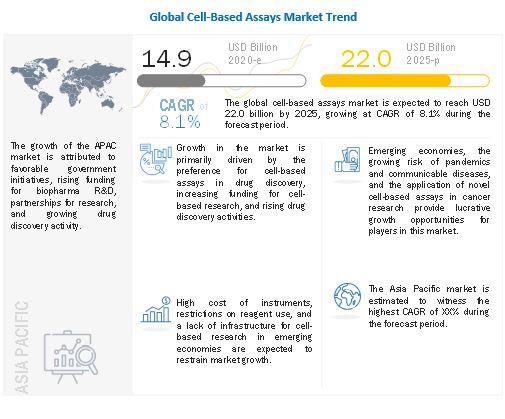
The increased demand for research on COVID-19 has created a large scope for cell-based 45 assays in viral infection research, vaccine development, and overall drug discovery for both researchers and laboratories.
Currently, a number of vaccines or antiviral drugs for COVID-19 have been approved or are under development, and patients are currently treated symptomatically. For both vaccines and therapeutics, the antibodies produced are tested for their functional efficacy to neutralize the target virus.
Cell-based assays are employed to shorten the time and increase the throughput needed for these assays. This has significantly increased the demand for cell-based assays to provide an early indication of the toxicity characteristics of the drug candidates.
The growing preference for cell-based assays in drug discovery, increasing funding for cell-based research, and growth in the number of drug discovery activities are the key factors supporting the growth of the market.

Cell-based assays are key components in the drug development process. Cell-based assays have several advantages over in vitro biochemical assays. They offer consistent tissue-specific responses in a biologically relevant microenvironment as opposed to biochemical assays. It is also not possible to prepare or purify every target for biochemical measurement, which is a major factor limiting the applications of biochemical assays.
For More Information, Download PDF Brochure @ https://www.marketsandmarkets.com/pdfdownloadNew.asp?id=119917269
The conventional methods of toxicity and drug safety assessment (involving animal testing) are expensive, time-consuming, and offer low-throughput. In this regard, modern cell-based assays merge the advantages of cell cultures and animal models to allow researchers to identify problems with lead compounds in early screening, ensuring greater efficiency in the drug discovery and development process.
Additionally, the physiological relevance of cell-based assays, as well as their ability to provide efficient, cost-effective, and accelerated drug discovery solutions, has also fueled their greater adoption among end users.
The introduction of high-throughput screening (HTS) and high-content screening (HCS) technologies in cell-based assays has increased their reliability. However, these technologies have also resulted in a significant increase in the cost of instruments.
The growth of the reagents market is restricted by a different factor—product end-user licenses restrict the use of reagent kits only to specified assays. Due to this, even though better and superior reagents are available in the market, customers are restricted to using only those reagents specified in the license agreement. This may act as a barrier to the growth of the cell-based assays market.




























